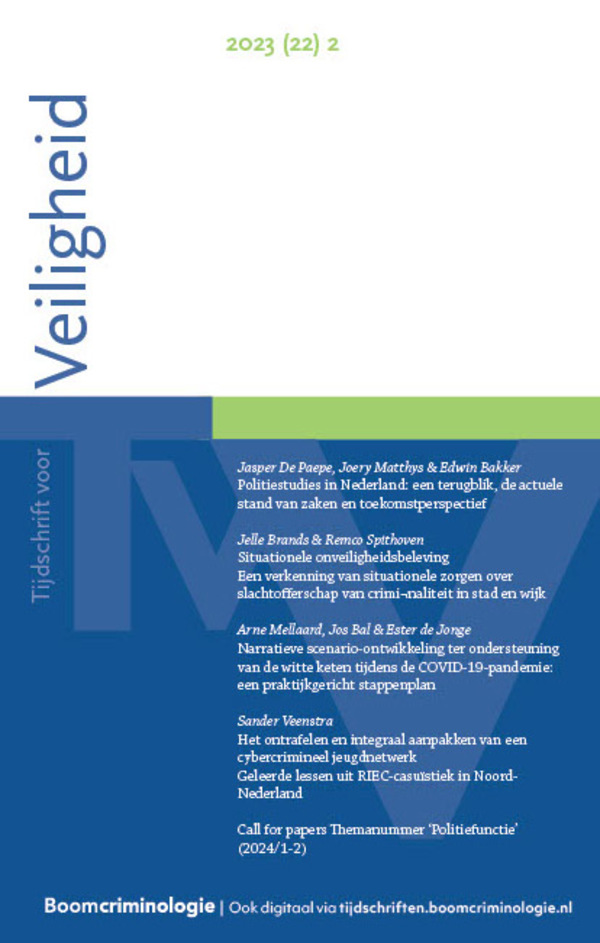|
Virtual reality is increasingly used in our society. Also in the field of physical safety this technique is applied. In this article we give an overview of virtual reality applications that are used in the Netherlands in this domain. This overview is divided into the five phases of the integrated emergency management system of the Netherlands. Based on international studies from other fields we try to indicate where in the near future virtual reality also can be used. |


Tijdschrift voor Veiligheid
Over dit tijdschriftMeld u zich hier aan voor de attendering op dit tijdschrift zodat u direct een mail ontvangt als er een nieuw digitaal nummer is verschenen en u de artikelen online kunt lezen.
| Redactioneel |
Redactioneel |
| Auteurs | Joyce Kerstens, Leontien M. van der Knaap en Ralf Beerens |
| Auteursinformatie |
| Artikel |
Het gebruik van virtual reality in de veiligheidsketen |
| Trefwoorden | Virtual reality, augmented reality, physical safety, integrated emergency management system |
| Auteurs | André Groenewoud en Margrethe Kobes |
| SamenvattingAuteursinformatie |
| Artikel |
Agenten volgen via Twitter bevordert positieve beeldvorming, stimuleert de meldingsbereidheid en verandert de veiligheidsbeleving |
| Trefwoorden | Twitter, community policing, transparency, perception, willingness to report |
| Auteurs | Leon Veltman, Marianne Junger en Roy Johannink |
| SamenvattingAuteursinformatie |
|
Since November 2009, the regional police of Groningen facilitated their community officers with Twitter. According to the principles of community policing, they are enabled to shorten the distance between the police and citizens by giving them a direct connection. Such a connection should stimulate interaction, while at the same time it should make people feel more safe. In addition, Twitter also creates possibilities for the police to be transparent. Sharing of information should alter citizens’ perception towards the police. |
| Artikel |
Politieonderzoek in open bronnen op internetStrafvorderlijke aspecten |
| Trefwoorden | criminal investigation, surveillance, OSINT, investigation powers, legal basis |
| Auteurs | Bert-Jaap Koops |
| SamenvattingAuteursinformatie |
|
Analysing large amounts of data goes to the heart of the challenges confronting intelligence and law enforcement professionals today. Increasingly, this involves Internet data that are ‘open source’ or ‘publicly available’. Projects such as the European FP7 VIRTUOSO aim at developing platforms for open-source intelligence by law enforcement and public security, which open up opportunities for large-scale, automated data gathering and analysis. However, the mere fact that data are publicly available does not imply an absence of restrictions to researching them. This paper investigates one area of legal constraints, namely Dutch criminal-procedure law in relation to open-source data gathering by the police. Which legal basis is there for this activity? And under what conditions can foreign open sources be investigated? |
| Artikel |
Slachtofferschap van cybercrime in kaart gebrachtHacken, e-fraude, identiteitsfraude en voorschotfraude |
| Trefwoorden | cybercrime, hacking, online fraud, identity fraud, victim survey |
| Auteurs | Miranda Domenie, Rutger Leukfeldt, Johan van Wilsem e.a. |
| SamenvattingAuteursinformatie |
|
This article discusses the results of a Dutch study that focuses specifically on victimization of various forms of cybercrimes among civilians. The survey addresses the cybercrimes hacking, fraud through selling and auction websites, identity theft and fraud and advanced fee fraud. The results are based on a validated questionnaire which was posted amongst a representative sample of 21,800 citizens, the response rate was 10,314 (47 per cent). In this article of each of these cybercrimes the prevalence is shown. Concerning prevalence, the victim survey shows that in the twelve months preceding the survey 4.3 percent of all Internet users were victims of hacking, 2.4 percent were victims of online scams (by paying for a good or service but not receiving them), 0.8 percent were victims of identity fraud and 0.2 percent of advanced fee fraude. Of all victims, 11.9 percent was victim of more than one of the cybercrimes we studied for this article. If we compare this with figures of offline crime we see that in the Netherlands in 2010, 1 percent were victims of assault, 1.2 percent of burglary and 1.5 percent of sexual offenses. In comparison with these offline crimes, the cybercrimes in our study have significant numbers of victims. Among Internet users, we see that victims of hacking and fraud by auction or selling sites are more often youngsters than older people (for hacking 15 till 35 years in fraud 15 till 25 years), people without a partner are at higher risk than people with partners and people with indicated that their most recently completed education were low are more at risk than people with high education. Especially with the online fraud this is remarkable, because it appears that people who make the most purchases over the Internet are higher educated and mostly in 25 till 45 years old. |
| Artikel |
Identificatie van Nederlandse jongeren die risico lopen op internet |
| Trefwoorden | Youth, internet use, online victimization, risk profile, risk factors |
| Auteurs | Joyce Kerstens en Johan van Wilsem |
| SamenvattingAuteursinformatie |
|
This article describes the findings of a national representative survey on online victimization. The survey was conducted in the Netherlands in 2011 amongst youth aged 10 to 18. Purpose of this research is to identify various risk factors related to cyber bullying, online sexual activities and online financial crime (e.g. e-fraude and commercial deceit). More than 9 percent of the youths had negative experiences with cyber bullying, about 5 percent with e-fraude and over 11 percent with commercial deceit. Also unwanted online sexual solicitations (6%) and unwanted exposure to sexually explicit internet material (12%) occurred with some regularity. |
